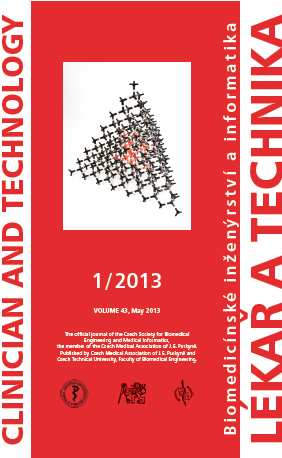FOTOTOXICKÝ VLIV PORFYRINOVÝCH SENSITIZERŮ A VIDITELNÉHO ZÁŘENÍ NA GRAM-POZITIVNÍ METHICILIN-REZISTENTNÍ KMEN S. AUREUS
Keywords:
antimicrobial photodynamic therapy, porphyrins, blue light, light emitting diodAbstract
The use of antimicrobial photodynamic therapy (aPDT) as a therapeutic modality for the treatment of localized microbial infections represents an developing new field. The emergence of strains resistant to antibiotics has provided the necessary impulse for new drug or technology discoveries to combat these resistant compounds. Although the aPDT is still in infancy, its need is still growing. Like PDT, main components of antimicrobial photodynamic therapy are appropriate light, dye called photosensitizer and created reactive oxygen species. In this article photosensitizers TMPyP and ZnTPPS4 are investigated for antimicrobial photodynamic therapy. We tested these porphyrins on bacterial methicilin – resistant strain MRSA alone and bound in complex created with hp-β-cyclodextrin. The light emitting diodes (414 nm) were used at the doses 0 and 150 J/cm2. Tested concentrations were from 0.78 to 100 μM. This experimental work predicated that TMPyP is very successful compound in aPDT. In contrary to ZnTPPS4 which was efficient for eradication of tested gram-positive bacteria only in higher concentrations.Downloads
Published
Issue
Section
License
Copyright (c) 2017 Adela Hanakova, Katerina Bogdanova, Katerina Tomankova, Klara Pizova, Jakub Malohlava, Svatopluk Binder, Robert Bajgar, Katerina Langova, Milan Kolar, Jiri Mosinger, Hana Kolarova

This work is licensed under a Creative Commons Attribution 4.0 International License.
Authors who publish with this journal agree to the following terms:
- Authors retain copyright and grant the journal right of the first publication with the work simultaneously licensed under a Creative Commons Attribution License (https://creativecommons.org/licenses/by/4.0/) that allows others to share the work with an acknowledgment of the work's authorship and initial publication in CTJ.
- Authors are able to enter into separate, additional contractual arrangements for the non-exclusive distribution of the journal’s published version of the work (e.g., post it to an institutional repository or publish it in a book), with an acknowledgment of its initial publication in this journal.
- Authors are permitted and encouraged to post their work online (e.g., in institutional repositories or on their website or ResearchGate) prior to and during the submission process, as it can lead to productive exchanges.
CTJ requires that all of the content of the manuscript has been created by its respective authors or that permission to use a copyrighted material has been obtained by the authors before submitting the manuscript to CTJ. CTJ requires that authors have not used any copyrighted material illegally, as for example a picture from another journal or book, a photo, etc. It is the author’s responsibility to use only materials not violating the copyright law. When in doubt, CTJ may ask the authors to supply the pertinent permission or agreement about the use of a copyrighted material.
The opinions expressed in CTJ articles are those of authors and do not necessarily reflect the views of the publishers or the Czech Society for Biomedical Engineering and Medical Informatics.


